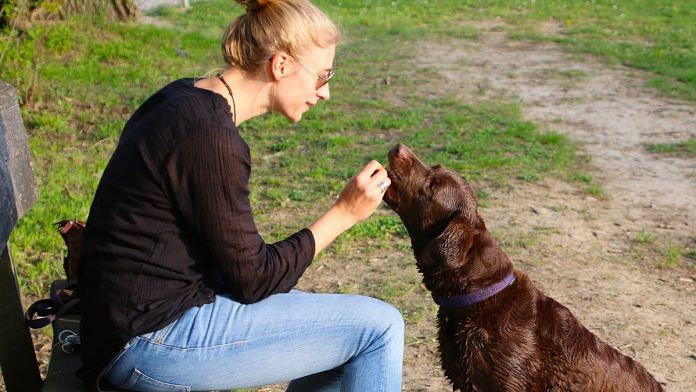Bengaluru: Domestication of dogs and how these canines have impacted human evolution has been a growing, inter-disciplinary subject of study. New research has now shown that sharing of leftover meat by Ice Age hunter-gatherers to wolves, whose descendants became dogs, may have had a role in their domestication.
Dogs diverged from wolves more than 27,000 years ago, choosing to live alongside and evolve with humans.
Published in the journal Scientific Reports, the study states that humans feeding leftover lean meat to wolves in harsh weather conditions during the last Ice Age (29,000 years to 14,000 years ago) could have contributed to the early domestication of dogs.
The new study varies from the two existing theories on domestication. While one established theory has noted that humans actively domesticated wolves for aid in hunting, another states that wolves were drawn to human food waste in settlements and eventually learned to co-exist. Researchers in the new study have offered dietary evidence to dispute existing theories.
Also read: Warm and humid climate make rocks more brittle, accelerate weathering, study finds
Friends more than foes
Both humans and wolves were hunters and belonged to a group of highly competitive carnivores. When there is an abundance of prey and environmental conditions are conducive, different predatory species are able to respect boundaries among one another. But they would compete for prey during leaner, winter months.
While wolves are typically hunters, human beings were evolutionarily herbivores and insectivores. Humans became scavengers and hunters later. This is one of the reasons why the human body does not seek or digest extra protein regularly, relying instead on carbohydrates and fats primarily.
In harsh winters, human hunter-gatherers during the Ice Age would have avoided lean meat and instead relied on parts from which fat and grease could be extracted abundantly. The researchers complemented their observations with the previous evidence of limb bones, from which fatty oils can be extracted, in ancient archaeological remains of human settlements.
Wolves, meanwhile, have evolved as carnivores and could thus survive for short periods of time on a solely protein-based diet.
The researchers have concluded that humans fed their discarded lean meat to wolf pups, which eventually led to the domestication of dogs.
To test their theory, the team calculated the “leftover energy for the main prey available to wolves” during the Late Pleistocene and Early Holocene periods. They calculated the lipid composition of various game animals in different seasons and were able to show that, even with very conservative numbers, the wolves could expend energy that was low enough to digest protein.
Their calculations also showed that nearly “every one of the prey species of wolves have protein ratios over the limit that humans can consume”. An overproduction of protein could have been fed to the wolves when kept as pets. As a result of this symbiotic meat-sharing, wolves and humans would not have been in competition with each other, but shared resources and evolved together.
Also read: There is a ‘natural aerosol factory’ in the Himalayas and it affects climate, study finds
Domestication of dogs
What we know about domestication of dogs from various studies is a lot, and yet very little. We understand the historic timeline of when things occurred, but not the motivations.
The firmest undisputed archeological evidence of a dog buried with humans is from 14,200 years ago in Germany. Dogs were domesticated before any other animal, including cattle. Humans started to domesticate boar, sheep, goats, and cows only about 10,000 years ago.
Furthermore, dogs were domesticated independently in multiple places.
As stated above, there are two primary theories about why dogs learned to live with humans. One has noted that humans actively tamed dogs for help with hunting, while the other said wolves were attracted to discarded food near human settlements.
The new research claimed that both theories do not fully explain the process of domestication, owing to differences in hunting habitats and climates, as well as scientific analyses claiming that the diet of ancient dogs differed from humans.
The new study offers evidence of meat sharing between humans and wolves.
“We suggest that the differences between dietary constraints of wolves and humans enabled dog domestication in harsh environments in the Late Pleistocene,” the authors have noted. “Excess protein decreased dietary competition and enhanced the possibility of sympatric existence. This could have been a significant impetus for wolves to become ‘our best friend'”.
Also read: 31 species extinct, all freshwater dolphins threatened — IUCN releases updated Red List



